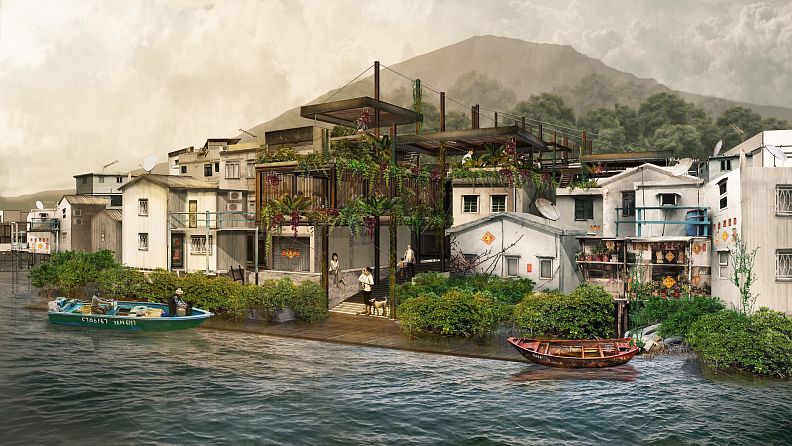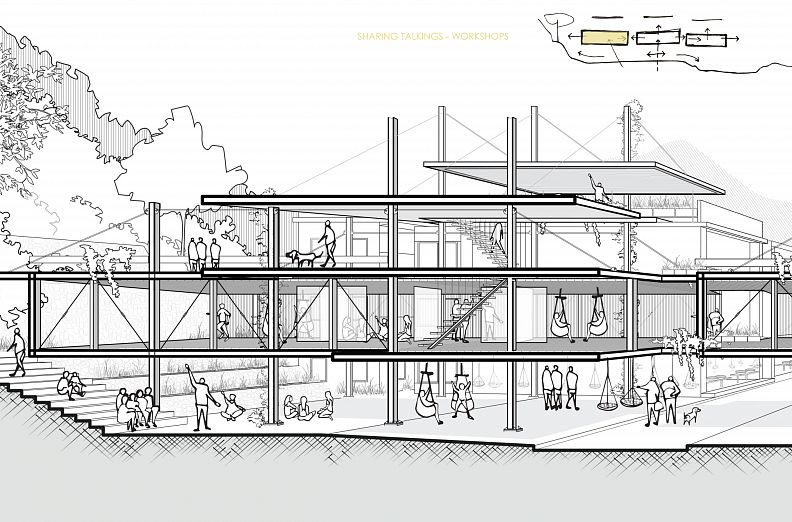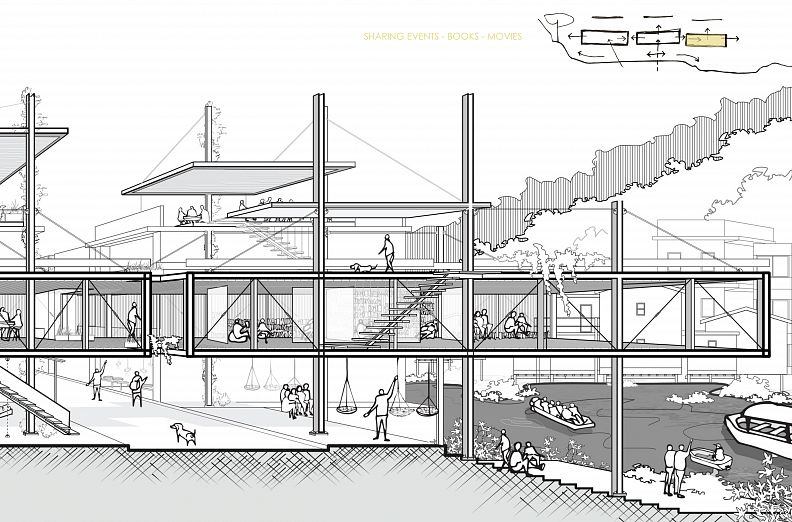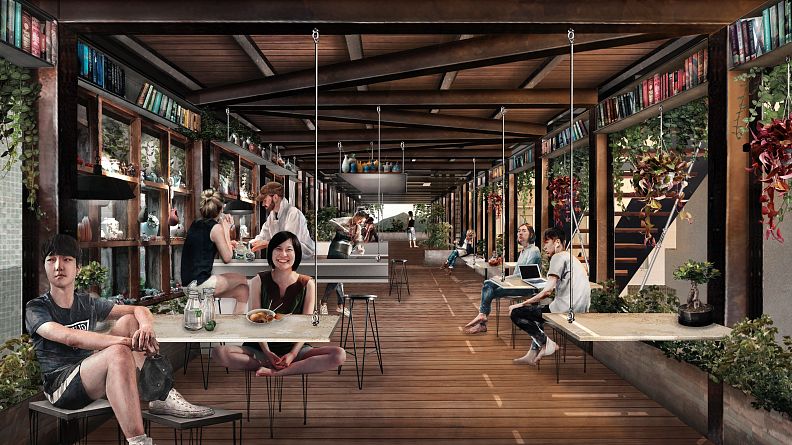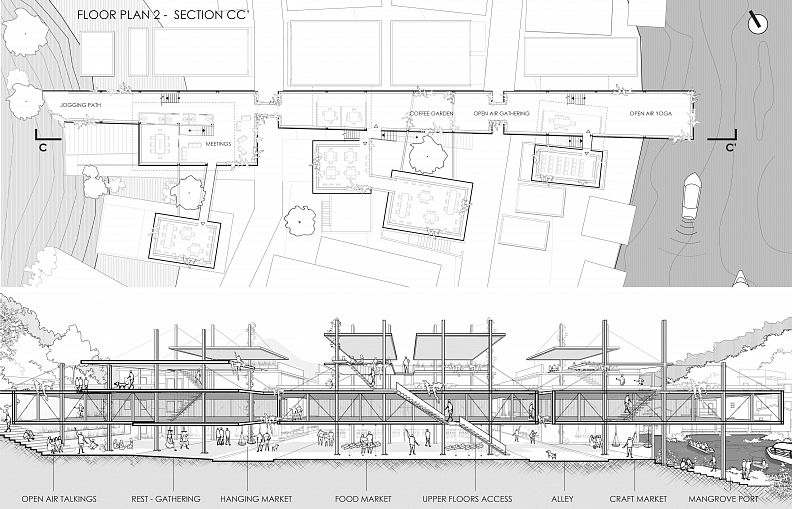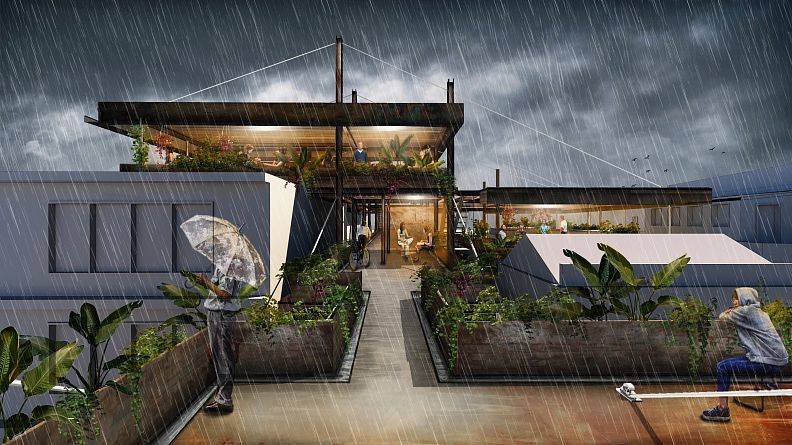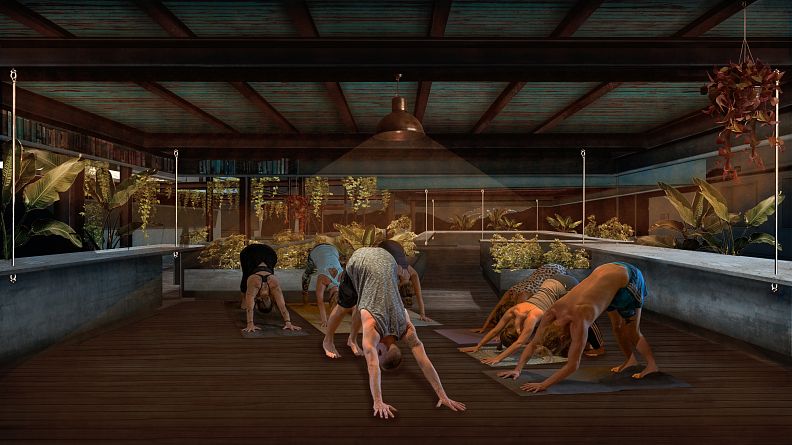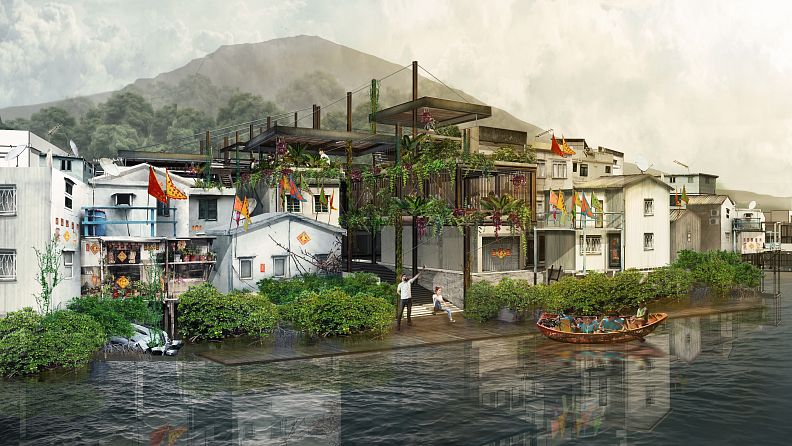Tai O Bridge Hub

Project idea
Tai O – Hong Kong village is facing the transition of fishing industry as the mainstay to tourism as the remaining income-generating industry. Some of the consequences have been: decline of job opportunities, migration, loss of physical and intangible heritage and the threatening to become a ghost town or a weekend resort. Due to this, the general aim of this thesis is to create a hub which: bridge traditional Tai O with contemporary economies and which help to reverse this migration and instead, attract human capital. The idea is to, while local traditions are potentiated and sustained, new entrepreneurships are developed. “Bridge Hub” is a center above the bridge that encompass diverse public life and productive spaces. It hosts local and international entrepreneurs in the diverse coworking spaces, and also welcome tourists to discover local commerce, architecture and natural surroundings.
This study beyond the design of a building, is a statement; a manifesto toward a historical village that is threatening to become a ghost town. This study illustrate architecture as a mean to strength the cultural and natural potentials that a community has to provide. And furthermore, it also illustrates the commitment of architecture to improve livability and inclusivity in the seeking of inhabitants well-being.
This study is not the design of a bridge as a passageway to cross from one side to the other, is rather an ideological and physical mean to foster Tai O to welcome an alternative economy. Tai O lived successfully the era of artisan and industrial economies; however, it has been stuck in the transition to a digital one. Thus, this project attempt to link the generation of young Tai O entrepreneurs with worldwide digital nomads. Furthermore, in the physical sense, Tai O Bridge Hub is a link with more than one connection, it is a series of networks embedded in micro-narratives.
This study has revealed that design strategies can intentionally improve livability and inclusivity in villages or cities. It doesn’t matter if cities are already consolidated or they are ancient towns, they still have the potential to be readapted in order to improve inhabitants well-being. This thesis is the seeking of design strategies that can break barriers and rather generate connections; it is the search of how to engage nature in social systems.
Hub above the bridge is a center to join a community, a village that needs to strength its basis which have represented the living traditions of all Hong Kong during last decades.
Project description
While new economies are emerging in Hong Kong Island, Tai O’s economy it’s been stuck and started to depends on tourism. However, contrary to an outside vision, its potential surpasses tourism as the main source. Due to this, the aim of this thesis is to find out: How to boost Tai O economy beyond a weekend resort? Furthermore, how to bridge the generation of young Tai O entrepreneurs with new economies? Especially considering that this is a vulnerable community that tend to migrate looking for new opportunities, instead of bringing them. The strategy of this thesis is to reverse this migration and instead, attract human capital. Thus, “Tai O Bridge Hub” is a center that encompass productive spaces to potentiate growing networks among locals and digital nomads that work remotely and face to face.
The purpose it’s to create a local and international headquarter merged into the existing context where people can work within collaborative or individual workspaces. The project is located within the neighborhood, commuting with existing houses and natural surroundings. All levels are directed toward the village, the hill and the creek to foster local productivity and to display the intangible culture and particular lifestyle. Its structure over stilts maintains the local traditional architecture typology in a contemporary way and open the ground flow to promote the sale of local products. “Tai O Bridge Hub” is a place to connect the ancient village with new economies, it works as a link between local dwellers, Hub workers and tourists. It is a place to share knowledge, but specially to add value to the cultural heritage.
Design strategies applied in this proposal intend to nourish livability and inclusivity in Tai O village. During the development of this thesis pandemic caused by Covid-19 hit the entire world. While living under a strict lockdown, it was prevailing to think about current neighborhoods conditions, and strategies seeking for future well-being. This study applies schemes that contribute specifically to Tai O, however, they are reflections that could be beneficial for villages in the future.
Technical information
Concept: Tai O Bridge Hub as its name states, it’s a bridge, but not the kind of bridge that will just provide a passage, it is a bridge of ideological and physical means. It is connecting elements of nature and neighbors; and also bridging an ancient village with a current and new economy. The concept of bridge might be understood in a physical and in a cultural way.
Program: The program distribution is based on: social level interaction and privacy degree level. Ground level is an open public passageway, the center is for collective purposes and upper floors for private activities. The program in general is composed by diverse functions for individual and collaborative purposes. The idea is that the project can work as an unprogrammed space where activities vary, depending on what users need.
“We examine architecture by zooming in on the micro-narratives embedded in the fragment” (Koolhaas, 2018) Architecture is not a mere building. Architecture is the physical manifestation of situations performed by people under historical and political contexts. It can only be understood when we look it closely, when we zoom in on those micro-narratives. Tai O Bridge Hub is a set of elements which foster a bunch of different situations. It is a sum of layers which can be read in horizontal and vertical views:
1. The first layer is composed by a series of elements from nature and built environment. At the moment, all these components are fragmented, urban distribution is divided by the alleys. Dwellers who have access to the creek, doesn’t have access to the hill, and so on. And the ones that are located in the center have no access to the creek or the hill. This disjointed distribution it’s repeated along the village, so the idea of this first layer is to free an axis and connect elements from nature.
2.The purpose of this second layer is to link what is already existing, in this case, rooftops of the two and three storey buildings located next to the new axis. These neighborhood bridges arise from the center and extend towards left and right houses.
3.Hanging market – hammock area: The structure over stilts open an inexistent connection between the hill and the creek. 39. The space invites diverse social and commercial activities and link the 2 alleys. 40. The hanging market is an extension of many of the groceries that characterized Tai O streets. And the dock is a place to arrive, but also a place to admire traditional stilt houses and occasional events.
4. Habitable bridge: it is a distribution point from where users can access and move toward all directions of the project. There are spaces to share workshop and talking’s, to share food and spaces to share books, movies and events. It is here where different situations can be performed by residents, hub users and tourists.
5. Streets-in-the-sky: this term was conceptualized as a collective space, as a horizontal access into a pedestrian net detached from ground-level. In this case, it is an elevated public pathway located in between existing buildings. Users can reach the co-working balconies or make use of this area for multipurpose activities without setting a foot in the ground floor.
6. Coworking balconies: this are spaces which have a private character which allows users to be focus on their work, and at the same time, they can use them for diverse activities during different hours of the day.
Climatic considerations: due to the hot and rainy weather conditions, some strategies were considered to provide interior climate comfort. The main strategy is to use greenery as a natural limit. It is wrapping all the spaces to control sunlight and heating.
Interior design: According to the locals, the early stilt houses were made of ‘broken boats, boats which were obsolete and could no longer be used. Nowadays houses are still built by recycled metal sheets, tinplate and scrap which has gave to Tai O a composition made of pieces and textures. So this project is a unifier element which; while composed by same materiality of the neighborhood, it has a uniform system.
Structure criteria: it is a skeleton made by steel pieces and a tensile system. The tensile system is in order to reduce the weight over rooftops. This is a light prefabricated structure, built by a dry construction system and assembled on-site.
Co-authors
Li Xiaodong





